Published on March 25, 2025 4:35 PM GMT
Solar has an average capacity factor in the US of about 25%. Naively, you might think that to turn this into a highly-available power source, you just need to have 4x the solar panels, plus enough batteries to store 75% of a day’s worth of power. E.g., for each continuous megawatt you want to supply, you need 4 MW of solar panels, and 18 MWh of batteries. During the day, you supply 1 MW from the panels and use the other 3 MW to charge the batteries. Overnight, you discharge the batteries to supply continuous power.
Turns out it’s not quite that simple. First, the capacity factor varies throughout the year, as the days get shorter in winter. So you at least need to build enough that even on the shortest day of the year, you can charge up enough to last through the longest night. (Hopefully you’re not inside one of the polar circles… at the poles, you’d need enough batteries to last through 6 months of darkness.)
Second, cloud cover will reduce the amount of power received in irregular and hard-to-predict ways. Here’s a chart from Casey Handmer showing the fluctuations in daily power at one site in Texas, which shows both seasonal and random variation:
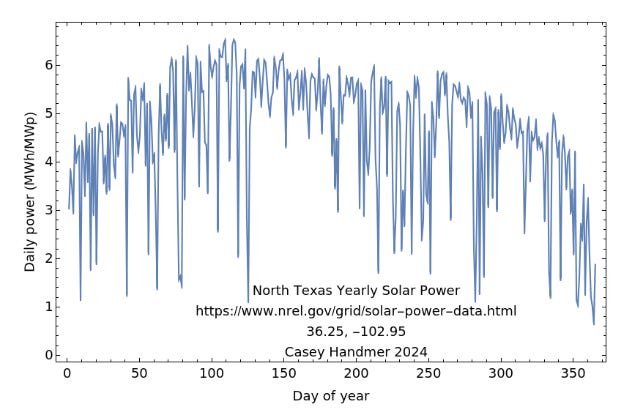
Third, the load you need to supply is often not continuous. Residential loads vary a lot throughout the day and throughout the year. The more the load is weighted towards nighttime and winter, the more batteries and extra solar panels you’ll need. And the load can also vary in hard-to-predict ways.
So the cost of the system depends a few factors. One is your latitude. But another is exactly how available you want the system to be. And it turns out that the costs rise steeply as you approach 100%. That is, if you want to prepare for the absolute worst case—a run of very cloudy days in winter, combined with higher-than-expected load occurring at inconvenient times—you have to build a lot panels and batteries.
Brian Potter recently modeled a simple solar-plus-battery configuration. In his model, for a house in Atlanta, solar with no batteries costs 5.7¢/kWh, but of course only covers about 25% of the needed electricity. To supply 80%, a kWh of electricity now costs 19¢. At 90%, it’s about 25¢; and at 99%, it’s 40¢:
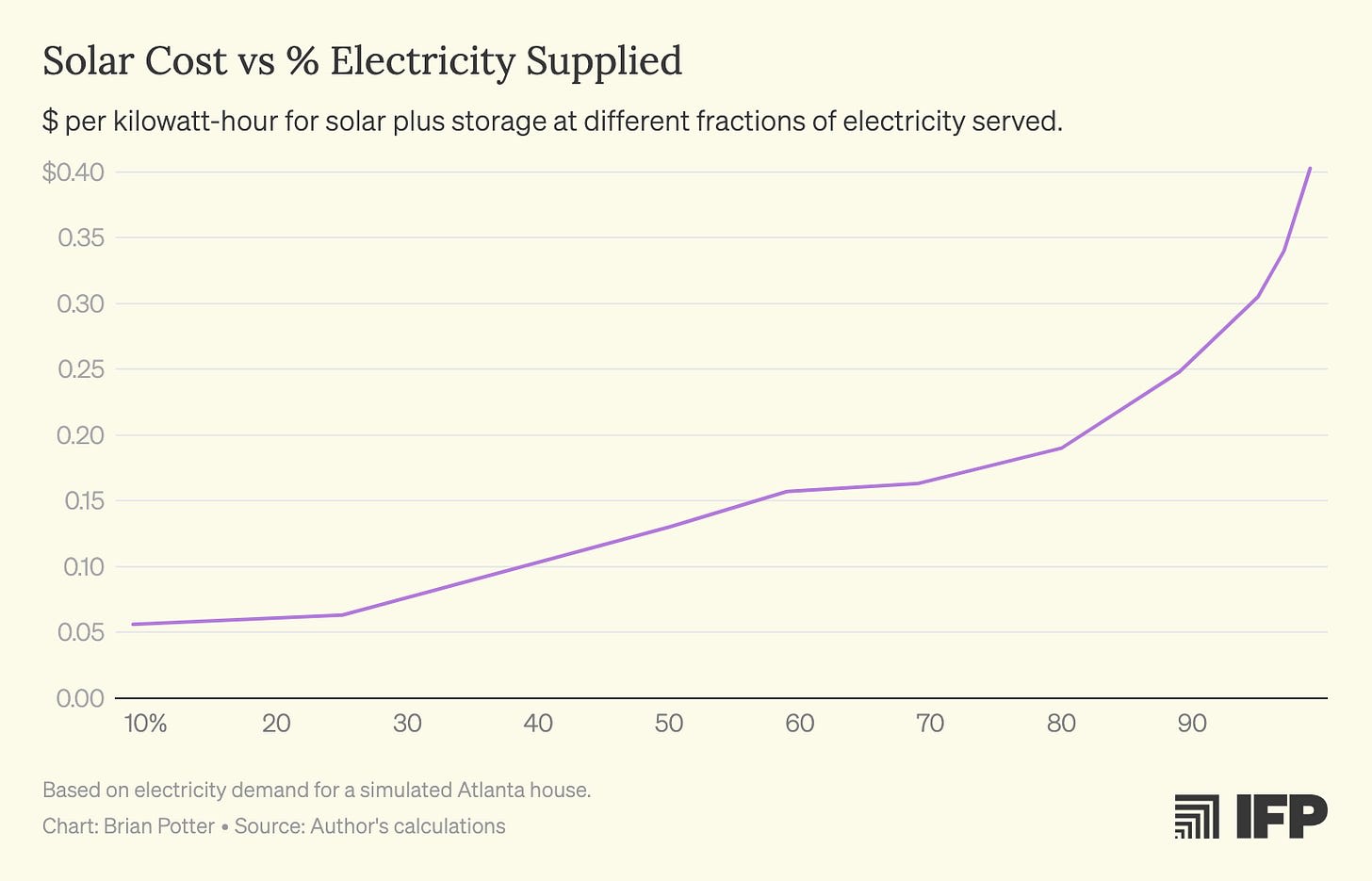
Casey Handmer found a similar curve:
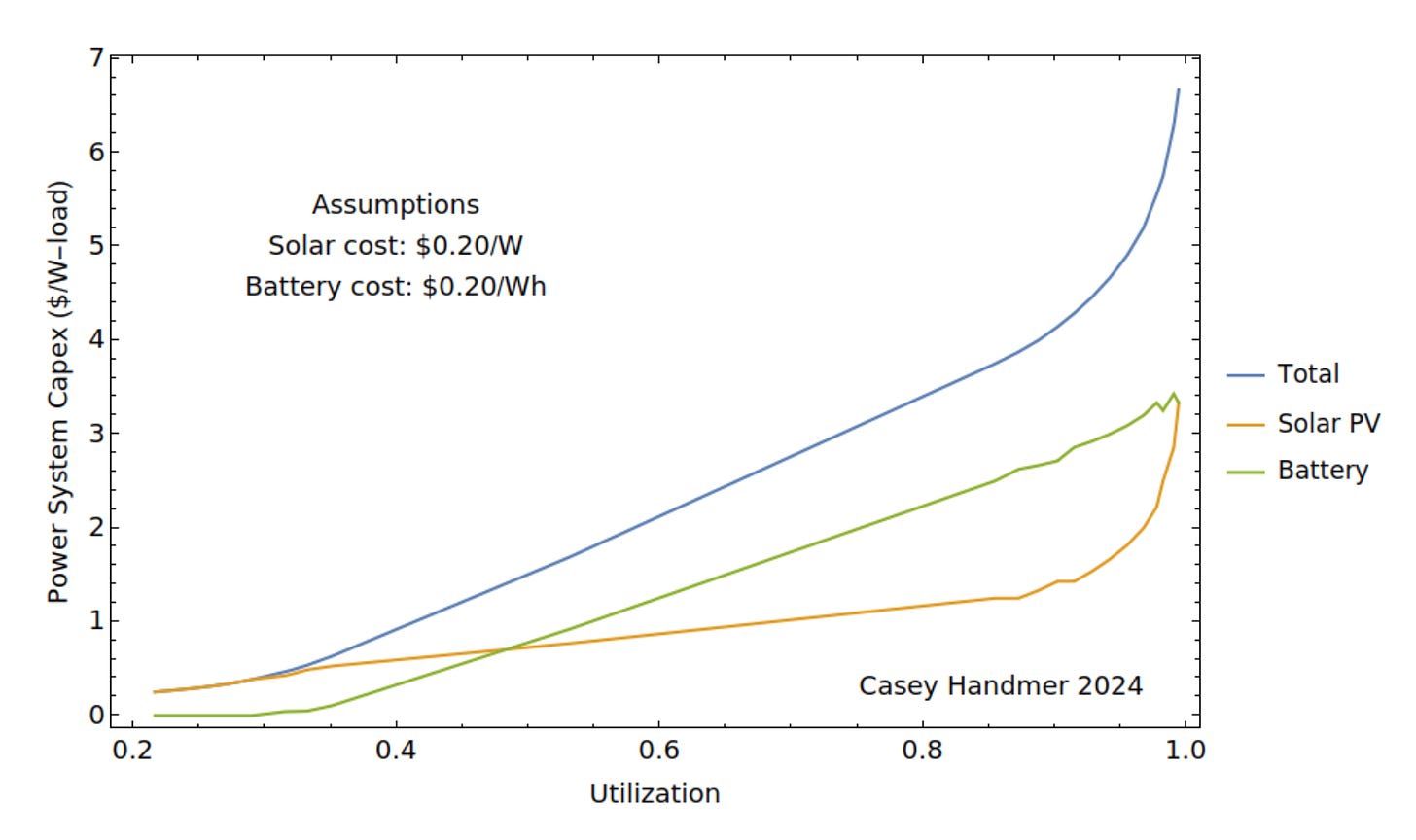
As did this report on off-grid solar for data centers:
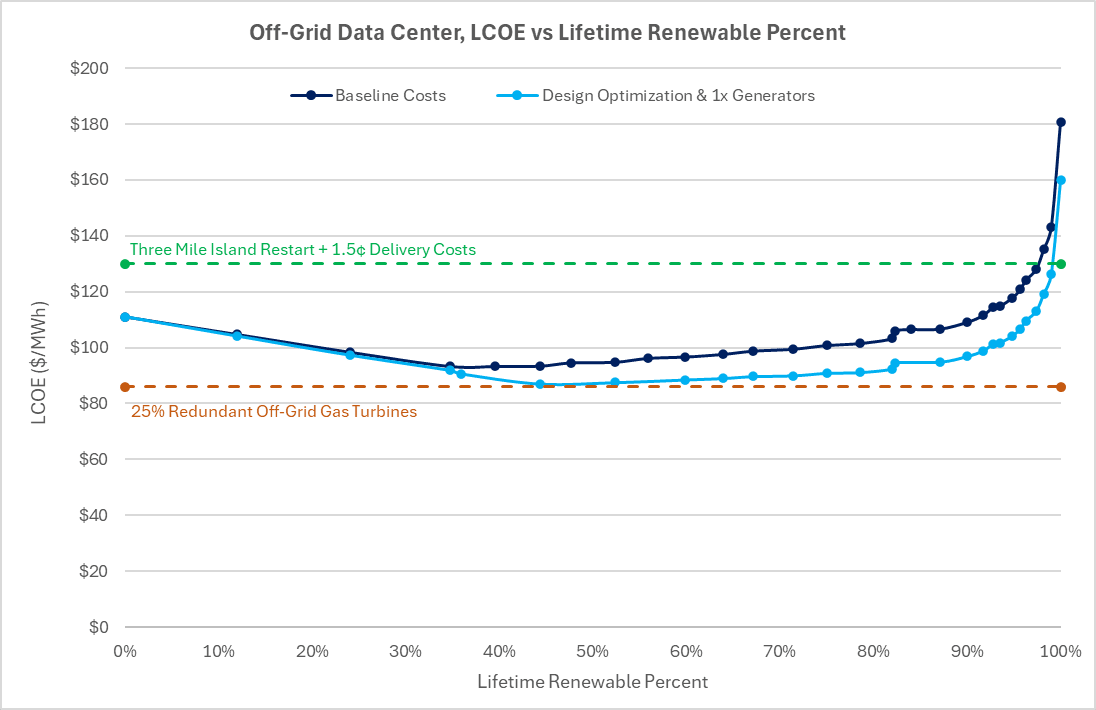
How much reliability do we need?
The US power grid has about 3-nines uptime (that is, 99.9%). This is considered unreliable: it means several hours of outages per year. Places like Germany, Japan and Singapore achieve closer to 5 nines: only a few minutes of outage per year. Let’s say 3 nines is a minimum and at least 4 nines (just under an hour of outage per year) is a better target.
Brian’s chart only goes up to 2 nines. I can’t eyeball the other two charts because they’re not on a logarithmic x-axis, so anything past about 2 nines is too close together. But in Brian’s model, even getting 2 nines increased costs about 7x from the baseline with no batteries. Given how steeply that curve is rising at the end, I can only guess that getting to 3 or 4 nines would drive up costs even more.
But wait, supplying power to the grid is not the only use case for solar. Solar is being used or considered for a variety of smaller, standalone, industrial applications. Casey’s company Terraform Industries is using it for methane production, and is designing the system to work intermittently, with no batteries. Even a data center doesn’t need very high uptime if it’s being used for offline processing, such as training AI models, instead of an online service.
Casey built a model of such use cases. His analysis is that what matters is the capex of the equipment you are powering, and the amount of power it takes to run, or specifically the ratio between those two. What he found was that if your equipment costs less than about $1/W, you’re best off using little to no batteries, and just running it for a fraction of the day. For more expensive equipment (like a data center full of GPUs), you want to build enough solar and batteries to run it almost continuously.
OK, but what about the grid? Well, here’s what Michael Cembalest has to say in a recent report:
I’ve been critical of marginal levelized costs of electricity cited for wind and solar since such measures typically do not incorporate costs of backup power or energy storage. I also don’t trust the rigor of back-of-the-envelope efforts by Lazard and others to estimate “grid firming costs” for wind and solar. That’s said, I also see little value in computing levelized cost of wind or solar in isolation even when including necessary overbuilding and storage, since no one would build a wind/storage-only or solar/storage-only grid in the first place.
What matters most is the systemwide cost of deeply decarbonized grids. Our grid optimization model uses real-world data on hourly generation by source, demand and reserve margins for the five largest ISO regions. The goal: determine the configuration of solar, wind, gas, carbon capture and battery storage, combined with existing nuclear and hydro, that can meet demand at the lowest cost and reduce carbon intensity. For those interested in the mechanics, we describe the entire exercise in supplementary materials linked below.
The results: we estimate that systemwide levelized costs of electricity would increase by 15%-35% in today’s dollars to increase the zero-carbon share of power by ~30% [points], with abatement costs of $85-$165 per metric ton of CO2. I consider these results to be a lower bound since they exclude future increases in load due to electrification of transport and home heating, and due to increasing demand from data centers.
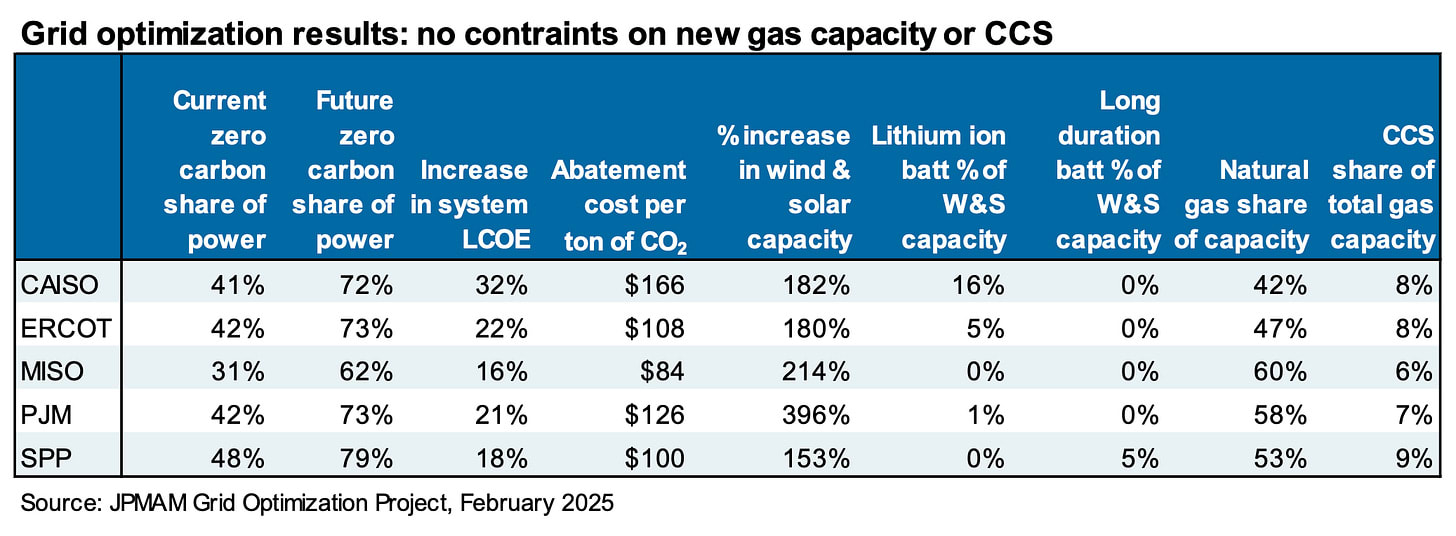
But the costs of both solar power and battery storage are dropping rapidly. Maybe soon it will be so cheap that we can get 2, 3 or even 4 nines uptime cheap enough to compete with reliable, dispatchable natural gas?
This is unclear to me, because (1) again, I’m not sure how much 3 or 4 nines costs, and (2) it’s unclear to me how fast the cost of power and storage will continue to fall. Even if assume PV panels and lithium-ion batteries continue to get rapidly cheaper with no bottom in sight, we’re approaching the point where Baumol/Amdahl/bottleneck effects will take over. Already the modules themselves are a minority of the cost of a solar installation; eyeballing this chart from an IRENA report, it looks like they’re about a third. Racking, mounting, and other equipment; labor; and soft costs each make up a significant fraction. Of course, these can be reduced too, and the cheaper the panels get, the more pressure there will be to do so.
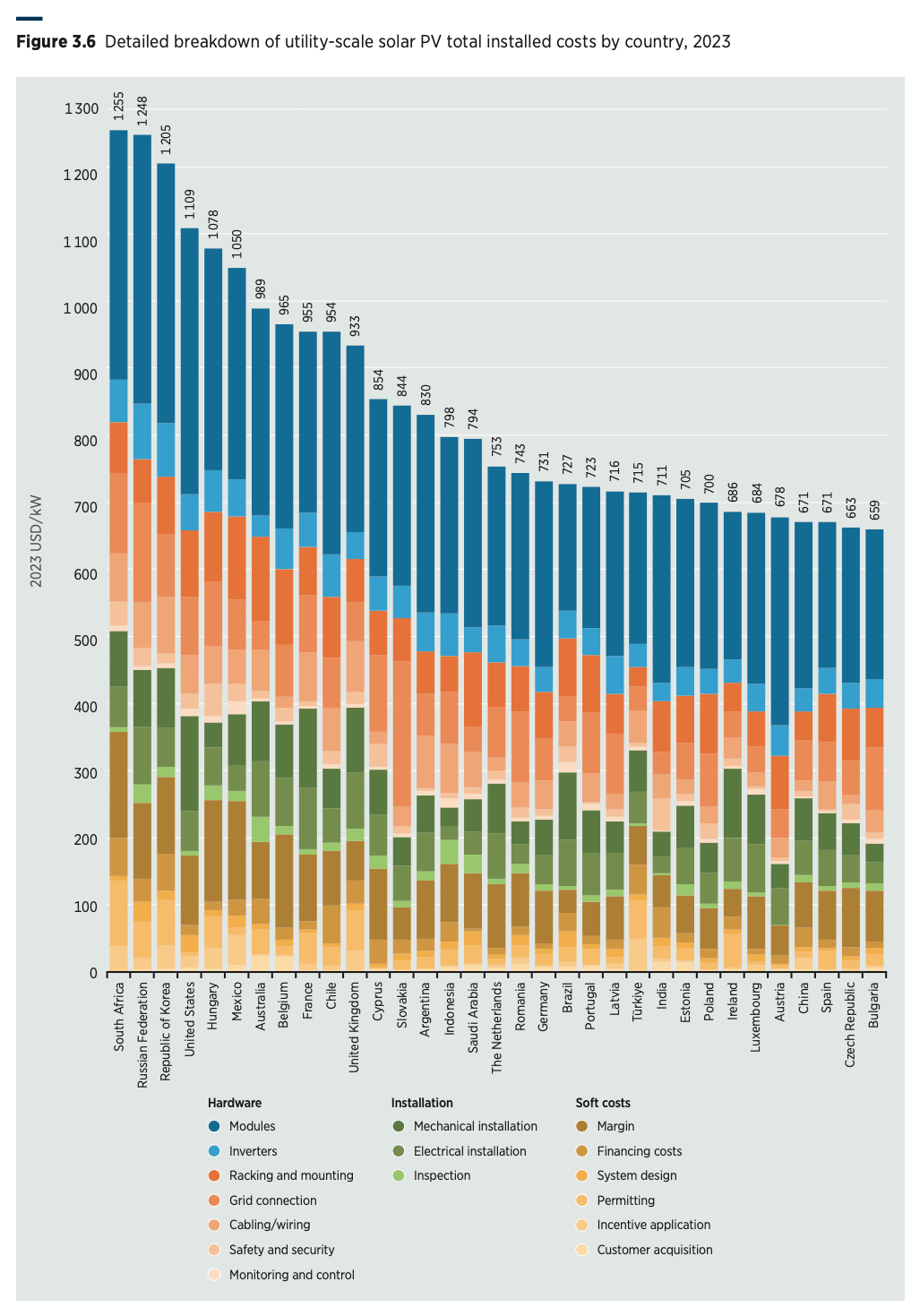
But my tentative bottom line is: solar + batteries can be great for specific applications that don’t need very high availability; and they can work as part of an overall system of supplying power to the grid; but they won’t supply all power to the grid in the foreseeable future. (And of course this is unchanged if you add in wind or any other intermittent, non-dispatchable source.)
Anyway, mostly putting this out there to collect what I’ve found so far, and so that people with better information or opinions can chime in and clarify or fill in missing pieces.
Discuss

